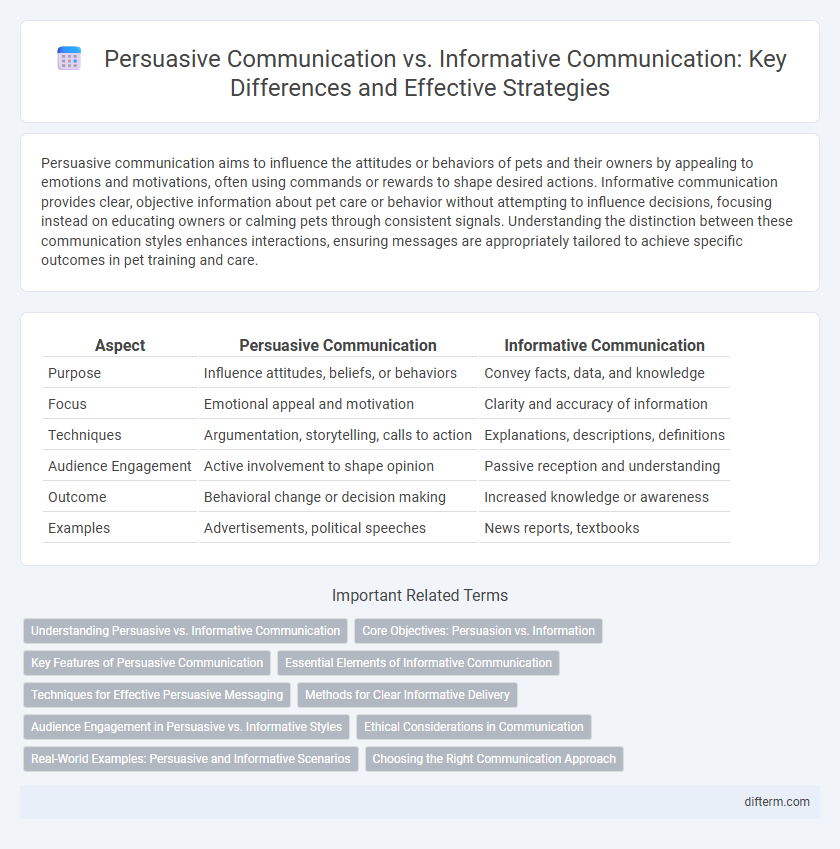Persuasive communication aims to influence the attitudes or behaviors of pets and their owners by appealing to emotions and motivations, often using commands or rewards to shape desired actions. Informative communication provides clear, objective information about pet care or behavior without attempting to influence decisions, focusing instead on educating owners or calming pets through consistent signals. Understanding the distinction between these communication styles enhances interactions, ensuring messages are appropriately tailored to achieve specific outcomes in pet training and care.
Table of Comparison
| Aspect | Persuasive Communication | Informative Communication |
|---|---|---|
| Purpose | Influence attitudes, beliefs, or behaviors | Convey facts, data, and knowledge |
| Focus | Emotional appeal and motivation | Clarity and accuracy of information |
| Techniques | Argumentation, storytelling, calls to action | Explanations, descriptions, definitions |
| Audience Engagement | Active involvement to shape opinion | Passive reception and understanding |
| Outcome | Behavioral change or decision making | Increased knowledge or awareness |
| Examples | Advertisements, political speeches | News reports, textbooks |
Understanding Persuasive vs. Informative Communication
Persuasive communication aims to influence attitudes, beliefs, or behaviors by appealing to emotions, logic, and credibility, often using rhetorical strategies tailored to the audience. Informative communication focuses on delivering clear, factual, and unbiased information to increase knowledge and understanding without seeking to change opinions. Understanding the distinction between these communication styles is crucial for crafting messages that effectively achieve desired outcomes in marketing, education, and interpersonal interactions.
Core Objectives: Persuasion vs. Information
Persuasive communication aims to influence attitudes, beliefs, or behaviors by appealing to emotions, values, and logic, often using rhetoric and motivational language to drive action. Informative communication focuses on delivering clear, accurate, and unbiased data or facts to enhance understanding and knowledge without attempting to change the receiver's viewpoint. The core objective of persuasive communication is to inspire decision-making or behavior change, while informative communication prioritizes education and clarity.
Key Features of Persuasive Communication
Persuasive communication aims to influence the audience's attitudes, beliefs, or behaviors by appealing to emotions, values, and logic using techniques such as ethos, pathos, and logos. It often includes a clear call to action, emotional appeals, and credible evidence to motivate change or decision-making. Unlike informative communication, which focuses on presenting facts objectively, persuasive communication strategically shapes messages to achieve specific behavioral responses.
Essential Elements of Informative Communication
Informative communication centers on clarity, accuracy, and neutrality to effectively convey facts or data without bias or persuasion. Essential elements include a well-structured message, credible sources, and a logical flow that enhances audience understanding and retention. This approach ensures the audience receives clear, objective information to make informed decisions.
Techniques for Effective Persuasive Messaging
Effective persuasive communication employs techniques such as emotional appeal, credible evidence, and clear calls to action to influence audience attitudes and behaviors. Utilizing storytelling and repetition enhances message retention, while tailoring language and tone to the target audience increases engagement and trust. Incorporating social proof and addressing counterarguments strategically strengthens the overall persuasive impact.
Methods for Clear Informative Delivery
Effective informative communication employs structured methods such as using clear, concise language, visual aids, and logical sequencing to enhance audience understanding. Persuasive communication, in contrast, often integrates emotional appeals and rhetorical techniques aimed at influencing attitudes or behaviors. Clear informative delivery relies on factual accuracy and simplicity to ensure the message is comprehensible without bias or manipulation.
Audience Engagement in Persuasive vs. Informative Styles
Persuasive communication actively involves the audience by appealing to emotions, values, and beliefs, creating a compelling call to action that motivates behavioral change. Informative communication prioritizes clarity and accuracy, delivering facts and data to enhance understanding without necessarily invoking emotional responses. Audience engagement in persuasive styles tends to be higher due to strategic use of storytelling and rhetorical devices, while informative styles rely on structured content and evidence to maintain attention.
Ethical Considerations in Communication
Ethical considerations in persuasive communication emphasize transparency and respect for audience autonomy, ensuring messages do not manipulate or deceive. Informative communication prioritizes accuracy and objectivity, delivering facts without bias to maintain trust and credibility. Both forms demand accountability to ethical standards that uphold honesty and protect the integrity of the communication process.
Real-World Examples: Persuasive and Informative Scenarios
Persuasive communication is exemplified in marketing campaigns that convince consumers to purchase products by appealing to emotions and desires, such as Apple's "Think Different" advertisement. Informative communication can be seen in public health announcements like the CDC's COVID-19 updates, which provide factual data and guidelines to educate the public. Both approaches utilize targeted messaging strategies to achieve distinct objectives: persuasion aims to influence decisions, while information aims to increase awareness and understanding.
Choosing the Right Communication Approach
Persuasive communication aims to influence attitudes or behaviors by appealing to emotions and values, while informative communication focuses on delivering clear, factual data to enhance understanding. Selecting the right approach depends on the goal: use persuasive techniques to motivate action or change perspectives, and choose informative methods to educate or clarify complex information. Effective communicators assess audience needs, context, and desired outcomes to balance persuasion and information for maximum impact.
persuasive communication vs informative communication Infographic

 difterm.com
difterm.com